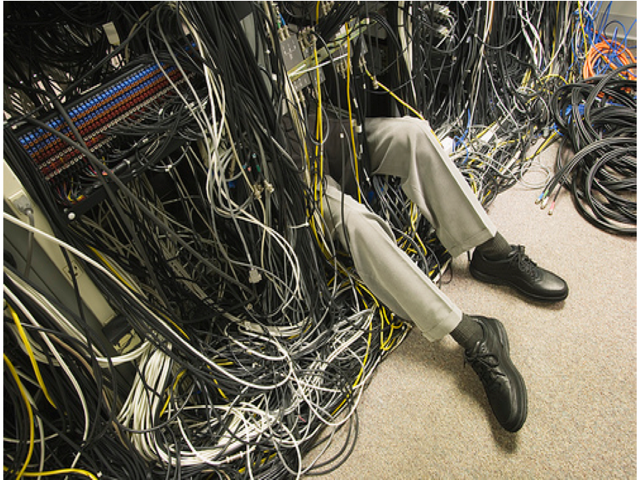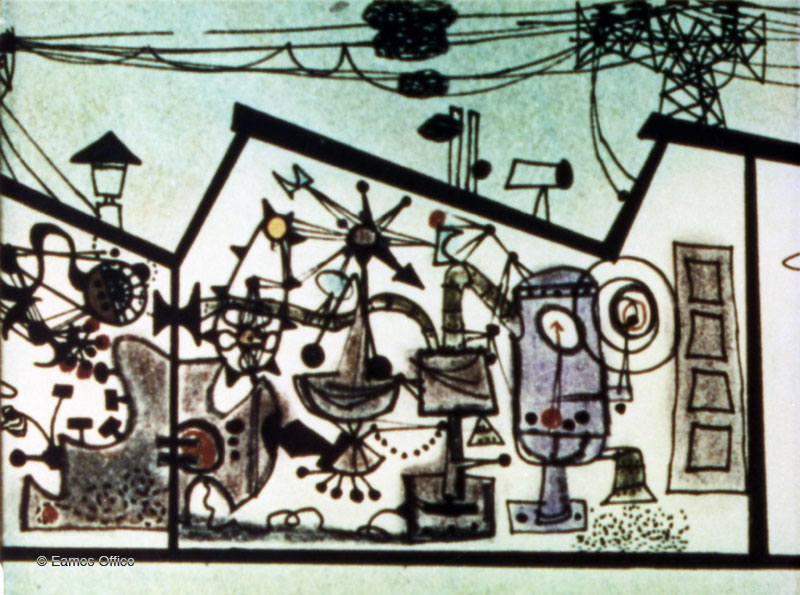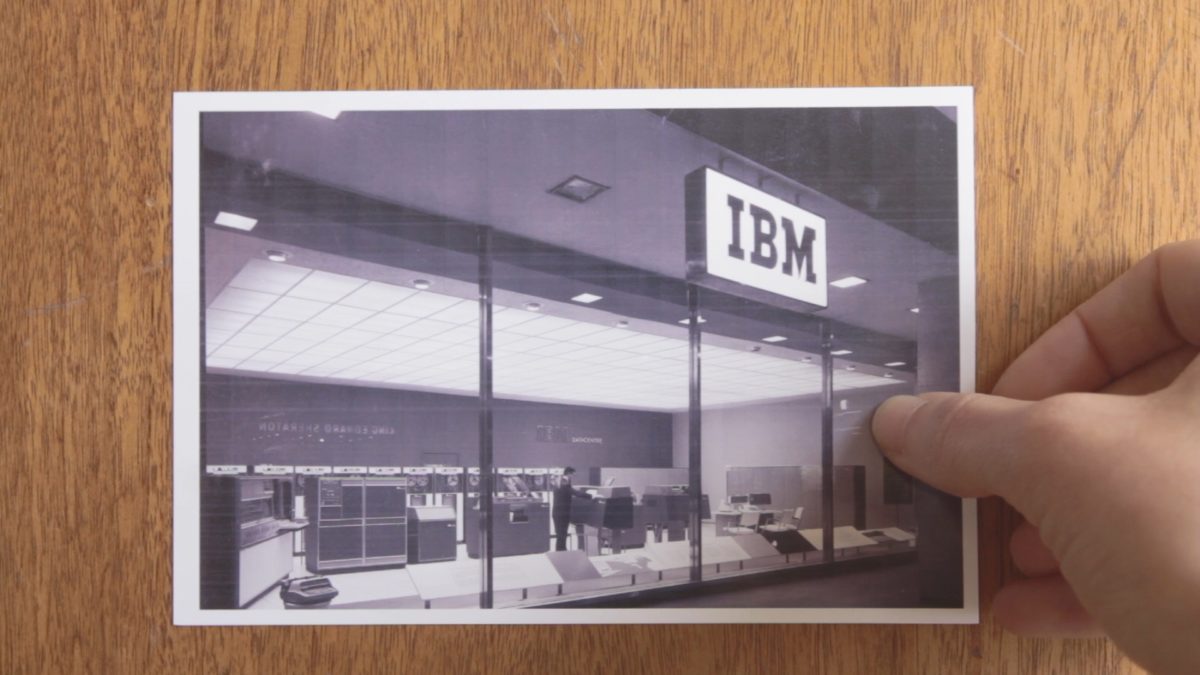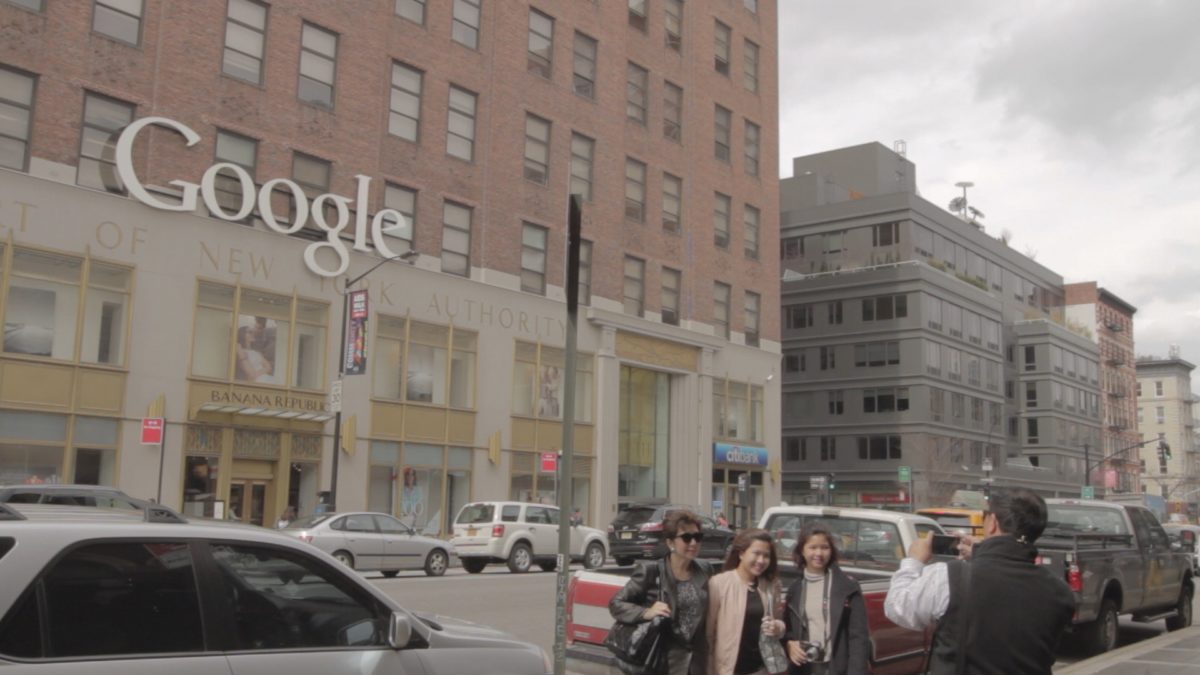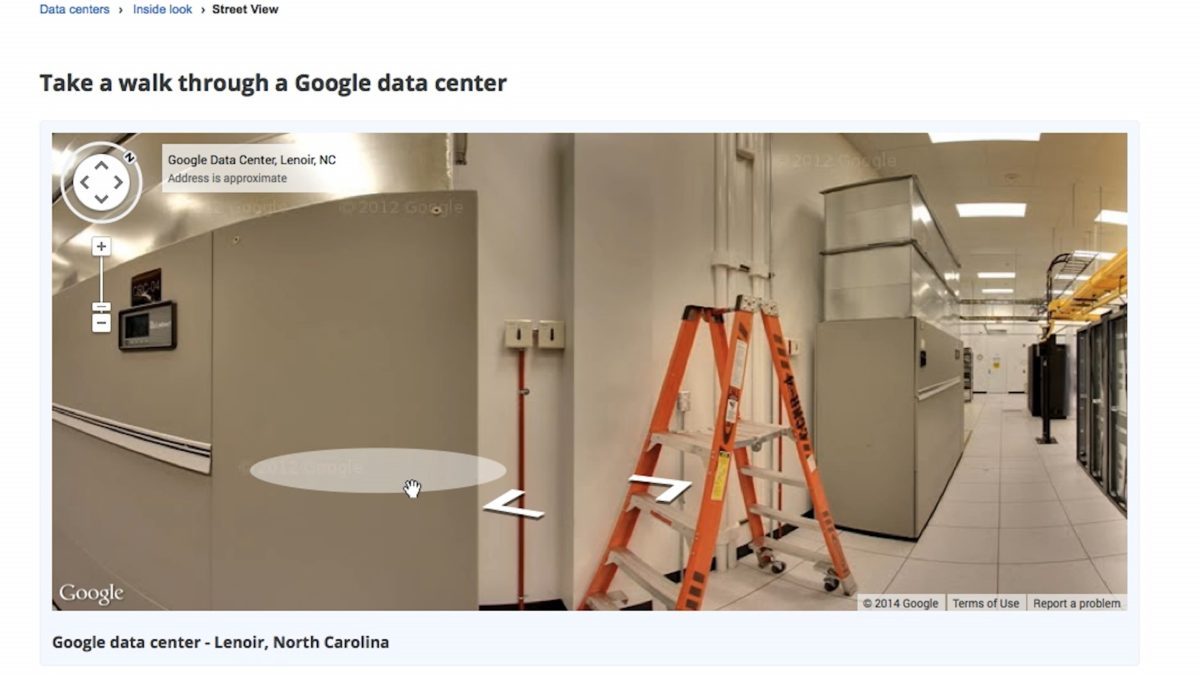Lost in the Cloud – The Representation of Networked Infrastructure and its Discontents
At the 1958 World’s Fair in Belgium, IBM showcased the wonders of computer technology and what it could offer humanity. They screened a short film, The Information Machine, by the offices of Charles and Ray Eames. The ten-minute, primarily animated film, aimed to introduce and demystify the societal benefits of computer processing to the wider public, but it did so through an intriguing contradiction regarding the materiality of the technology itself.
The film begins by describing how the prehistories of human systems developed the ability to negotiate, govern and predict the uncertainties of the natural world. As the ability to amass increased amounts of information advanced, with it came the need to organize, calculate and make sense of all this data. This progression then culminated in the grand tool of mechanized calculation, bringing about the ability to see through the abstraction of overwhelming amounts of information. As explained by the Eames Office, “The Information Machine is ultimately the story of our continual need to process and communicate larger and more complex amounts of data, and how we learn to manipulate abstractions with increasing sophistication and skill.”1Eames Office, “The Information Machine”, 2016. Available at:http://www.eamesoffice.com/the-work/the-information-machine/ [accessed June 11, 2016]. The film’s opening story of the computer processor’s prehistory, tells a cautionary tale of hubris regarding prediction, speculation, and a hero’s inability “to consider and relate all the factors in a problem”. This is demonstrated by a familiar parable in which a character is granted three wishes “in a frantic effort to reap immediate reward”. The first wish is unwise, the second then over corrects for the misjudgment of the first, and if the hero is lucky, the third and final wish returns him back to where he first started. Human propensity towards misjudgment is further exasperated by the increasing complexity brought about by the very systems of logic that are intended to simplify and solve.
This is where the information machine, quite literally, enters the frame. For the first time, the film departs from the animated narrative into the ‘real world’ of a live action sequence in which the calculating machines are depicted in the photographic ‘real’ through the lens of a camera, and are thus “unburdened by artistic representation”2J. Hoberman, Film After Film After Film: (Or, What Became of 21st Century Cinema?), New York, London, Verso, 2012, p. 4. of the hand-drawn animation. “This is information”, the narrator authoritatively states, as the film pivots from endearing, child-friendly animation to the dry, formal documentation of the mechanical innards of these massive machines: punch cards, cables, tape reels, flashing bulbs, gears and sprockets, dispelling the “boogeyman which some see lurking behind every computer”. At times resembling a Fordist assembly line, familiar images of 20th century innovation uncoupled and abstracted from their particular function but indexically linked to the notion of progress.
These machines, we are told, will enable us to model complex systems with unprecedented fidelity, in order to make calculated decisions. The Eames duo wished to show us how computers would help us better represent the world, but curiously, the sole subjects documented in ‘the real’ are the machines themselves. The histories that led to this technology and its real world effects are left to be articulated by the language of hand-drawn illustrations, while the physical materiality of these machines demanded that they burst through the artifice of animation. By some sleight of hand, the Eames had rendered the technology, then still an object of myth and wonder, more real and humane than our everyday reality. Its impact on systems of governance and modes of production remained far too complex to be rendered within a photographic mise-en-scène. We are thus left with close-up images of a contraption, isolated and dislocated from its larger functioning and use. The filmmakers, it would seem, were fully aware of the limits of the representation of mechanic action. Regardless of the camera’s perspective or angle, the frame is never wide enough to entirely explain what we are seeing. What counted most was that the images of these machines depict the photographic ‘real’ in order for their meaning to be accepted.
Over half a century later the world is now increasingly enmeshed in an array of computers, sensors and various portable devices, gathering unfathomable amounts of data concerning every aspect of life, but the representation of this technology has not caught up yet.. Snaking cables still engulf rooms, only now mechanical drums of punch cards and Ampex reels have been replaced with anonymous server racks and blinking lights. The ambiguity of these images utters the same vague mantra: progress. One can almost still hear the authoritative voice of the Eames’ Information Machine gesturing towards these current images: this too is information. The once hand-drawn cartoon animation has been replaced with CGI animation, but no clearer picture has been provided as to the significance of what the viewer is seeing. In fact, it is quite often to the contrary. Corporate videos depict bodiless cameras floating down sterile white halls, gliding past glowing alien light sources, matrix-like sculptural forms of binaries morphed into fiber tubes, globes and webs. The machine of global computation is now a leviathan of such proportion that all forms of media, including the cinematographic image, have been absorbed into it, rendered binary and disseminated via a nexus of online outlets, and new consolidations of corporate power. Though its terrestrial presence is seemingly invisible, the singular static information machine of yonder has given way to a plethora of technologies, many of which are portable and ostensibly autonomous, but are in fact joined under the monolith of Big Data. Entangled with roads, railways, and other aging technologies and logistics, they help form what Keller Easterling has termed “infrastructure space”, a medium of information, a series of “invisible, powerful activities that determine how objects and content are organized and circulated”3Keller Easterling, Extrastatecraft: The Power of Infrastructure Space, London, New York, Verso, 2014, p. 13.. The vastness and complexity of this expanding space reiterates what the Eames’ cautionary tale warns of, an increasingly difficult landscape for one to “consider and relate all the factors” in a problem.
“All that is solid melts into air, all that is sacred profaned.” This is arguably one of Marx and Engels’ most poetic summations of both the history and future trajectory of capitalism. Marx and Engels memorably observed that both the modes of production and social relations are constantly revolutionized by the bourgeoisie, while new such forms “become antiquated before they can ossify”. Growth and expansion have become the only imperative, and global connectivity the ultimate tool: “The need of a constantly expanding market for its products chases the bourgeoisie over the entire surface of the globe. It must nestle everywhere, settle everywhere, establish connections everywhere”4Karl Marx, Friedrich Engels, The Communist Manifesto, 1848. Available at: https://www.marxists.org/archive/marx/works/1848/communist-manifesto/ch01.htm [accessed June 11, 2016].. In the 21st century, all that is sacred no longer appears to melt into air, but is rather rendered into data. Within the confines of networked technology, information and social relations are quantified and archived with the hope of future monetary value. All that is sacred is now permitted to ossify into the solid state of a data center, a structure that in turn melts carbon into the air. Our film, All that is solid Melts Into Data (2015) attempts to trace a rough history of the evolution and expansion of data processing and its effect on both how we perceive the world, as well as how we have shaped it. Despite being often perceived as an ethereal synonym of air, the film highlights how the weight of the cloud is growing.
By way of the data centre, the film presents a historical-material geography of the web, unpacking its juridical, architectonic, economic, and epistemological infrastructure – the ‘backbone’, so to speak – of this seemingly ephemeral, placeless, and both virtual and material phenomenon of networked technologies. From the outset of our investigation, we were faced with the double challenge of representing a nexus as complex and ubiquitous as the web, and a protagonist as abstract as data. Yet, gradually we realized that the story of how our world has come to be perceived by way of data through the lens of data analytics – though a difficult one to tell – is anything but abstract. Rather, it is very much a story of the persistence of matter. Energy and natural resources, labour conditions, the role of physical proximity, the gradual layering of technologies on top of each other, and the geographical contingency of juridical processes – all these questions play a central role within this history, and came to play a crucial role within our film. The ambition to find this ‘boogeyman’ lurking behind the infrastructure space of the data centre is split between a desire to show the cables, racks, dams and tunnels that constitute the ‘cloud’ and thus dispel a prevalent myth of a placeless and immaterial net-of-nets and a realization that merely exposing cables and flashing lights remains, in itself, a futile endeavor, offering little to elucidate the inner workings of these technologies. Brecht and Benjamin both cautioned of the ontological blind spot that results from an over-reliance of the photographic image’s abilities state that “less than ever does the mere reflection of reality reveal anything about reality” or “actual reality has slipped into the functional”5Walter Benjamin, Selected Writing Vol. 2, 1927-1934. Translated by Rodney Livingstone and Others. Edited by Michael W. Jennings, Howard Eiland, and Gary Smith. Cambridge, The Belknap Press of Harvard University Press, 1999, p. 526.. We therefore chose to complement this materialism with an introspective gaze – exploring not only the hidden visceral image of this technology, but also, the desire to see such an image. This ambivalence would translate into a corresponding formal division between footage filmed on-site and footage captured online. From the outset, our film commenced under the premise that one must use the Internet in order to research the Internet, rather than attempt to escape the network so as to represent it “objectively”.
Thus, our work began on our desktops at home, researching by ‘Googling’. We mapped the central nodes on the World Wide Web by virtually highlighting data centres and networked infrastructure ‘hidden in plain sight’ in nondescript buildings scattered around the power nexuses of the US and Europe: the American West Coast, The American Northeast, California, New York City and Frankfurt Germany. It is no coincidence that these are centers of global political and economic power, emphasizing the current hegemony of the Unites States and Western Europe within networked capitalism. At first, we ‘visited’ these remote locations by virtual proxy (thanks to Google’s extensive mapping initiatives), and subsequently, we began physically exploring the locations we had mapped, filming the opaque facades of switching hubs and the data centres that enable our instantaneous global communication. The physical mapping of networked technologies – whose wide spread effect has foreclosed spatial and temporal cognition beyond any previous technology – grafts quite perfectly onto the territorial order of neoliberal logic. This burgeoning data centre industry sits atop the juridical infrastructure, tax regulations, privacy laws, and national authority all initially laid out for earlier industries. To look to the materiality of networked technologies is in fact to look to their histories.
The newly built data centres in the Oregon desert of the American Northwest have come to replace recently the defunct industry of aluminium smelting plants, tanking energy from the Dalles Dam originally built for the benefit of that long-gone industry. Similarly, the New York Port Authority building on 111 Eighth Avenue was once a testament to 20th century industrial might – an essential hub of Maritime trade, passing goods and commodities from its eastern side to the western side that faces the Hudson River – and is now a refurbished symbol to the might of networked global connection. Owned by Google, the building resides above a central communications artery of New York City, the Hudson Street, Ninth Avenue “fiber highway”. Like hermit crabs, the infrastructures of the new digital age have come to inhabit the shells left by their industrial predecessors.
The web – in our phones, laptops, or Smartwatches – has reached a level of unprecedented intimacy with its users. It is often the last thing they see before going to sleep, and the first thing to greet them when they wake up. The old Hegelian dictum, which claimed that reading the morning newspaper is the realists morning prayer, has been superseded and accelerated ad absurdum by the obsessive compulsion of quantified-self advocates. Yet, despite its ever-growing pervasiveness, the infrastructure of the Internet is only becoming less visible. ‘The Cloud’ is a centralization project, emblematic of the logic of late capitalism: a harbinger of globalization; a vast and complex network, omnipresent yet largely invisible; a conduit of capital, enmeshing distant regions and actors. What could be more symptomatic of the abstractions of global capital than the metaphor of ‘The Cloud’ – the fantasy of a global computational machine without a ‘body’, and lacking any physical manifestation? Data centers and their clouds are but the most recent in a linage of technologies of global capitalism that obfuscate our relationship with our surrounding environment. Though it is often heralded as increasingly transparent, and as a new equalizer, the web thrives only by being swathed in obscurity and opacity. The data processing centers of the American Post War years were fittingly described as “The Glass House”, modernist cubes of transparent glass so that humans and machines could gaze back at one another. By the 1970s and 1980s, Cold War paranoia had mandated a turn towards Brutalist black boxes, imposing and anonymous, networked so that the loss of any one node would not compromise the entire system. These are the two contradictory poles that constitute our contemporary “Information Machine”, a paranoid network still desiring to be invisible but reluctantly mediating its own visibility through Starchitect quality edifices and slick corporate promos, dictating the terms of its own representation.
Take a tour through Google’s data centres via Google ST View or visit the Facebook page of Facebook’s Prineville’s Data Centre. Transparency is the new opacity. Charles and Ray Eames opened up the Information Machine in 1958, and over fifty years later we can still peer inside the belly of this beast with little to no better understanding of what we are looking at. Disembodied punch cards have given to server racks and lines of code. Perhaps this is where they want us to look, but if we are to better understand the contours of the data-driven present, let alone those of its future, mapping the material reality of its infrastructure is a necessary first step.
| ↑1 | Eames Office, “The Information Machine”, 2016. Available at:http://www.eamesoffice.com/the-work/the-information-machine/ [accessed June 11, 2016]. |
|---|---|
| ↑2 | J. Hoberman, Film After Film After Film: (Or, What Became of 21st Century Cinema?), New York, London, Verso, 2012, p. 4. |
| ↑3 | Keller Easterling, Extrastatecraft: The Power of Infrastructure Space, London, New York, Verso, 2014, p. 13. |
| ↑4 | Karl Marx, Friedrich Engels, The Communist Manifesto, 1848. Available at: https://www.marxists.org/archive/marx/works/1848/communist-manifesto/ch01.htm [accessed June 11, 2016]. |
| ↑5 | Walter Benjamin, Selected Writing Vol. 2, 1927-1934. Translated by Rodney Livingstone and Others. Edited by Michael W. Jennings, Howard Eiland, and Gary Smith. Cambridge, The Belknap Press of Harvard University Press, 1999, p. 526. |
Boaz Levin (b. 1989) is an artist, writer and occasional curator. He currently holds a position as a research associate at the UDK, Berlin, where, together with Hito Steyerl, Maximillian Schmoetzer and Vera Tollmann, he runs the Research Center for Proxy Politics (RCPP). Levin has presented his work internationally, most recently at the CCA (Tel-Aviv), Former West (HKW, Berlin), Recontres Internationales (Paris, Berlin), Fidmarseille (Marseille), EMAF (Osnabrück), Human Resources (LA) and the School of Kyiv (Kyiv biennial). Regarding Spectatoship, an ongoing curatorial research project co-curated together with Marianna Liosi, was shown at Kunstraum Kreuzberg/Bethanien Nov 2015-Jan 2016. Levin is a member of the curatorial team of the 7th edition of the FOTOFESTIVAL Mannheim-Ludwigshafen-Heidelberg (9.-11. 2017).
Ryan S. Jeffery (b. 1978) is an American filmmaker who lives in Los Angeles, California. His work has most recently been presented at the European Society for Literature, Science & The Arts Conference: Control, The European Media Arts Festival in Osnabrück, Human Resources: Climate & Infrastructure in Los Angeles California, La Gaîté Lyrique in Paris, Transmodern Architecture Forum in Berlin, FIDMarseille, The Kyiv Biennial and The Independiente Festival International de Cine in Peru. Jeffery has taught film and video at Syracuse University, UCLA, CalState University, Long Beach and will be at The School of Critical Studies at The California Institute of the Arts (CalArts) for the Fall of 2016.
